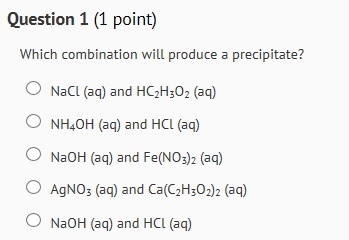

- #Which combination will produce a precipitate how to#
- #Which combination will produce a precipitate update#
#Which combination will produce a precipitate update#
Diabetic ketoacidosis: Update on management. Diabetic ketoacidosis and hyperosmolar hyperglycemic state in adults: Treatment. Diabetic ketoacidosis and hyperosmolar hyperglycemic state in adults: Clinical features, evaluation, and diagnosis. Ask your diabetes treatment team for help when you need it. Follow your diabetes treatment plan carefully.

But don't let fear keep you from taking good care of yourself. If you think you have diabetic ketoacidosis because your blood sugar is high and you have too many ketones in your urine, seek emergency care.ĭiabetes complications are scary. If you have low levels of ketones, you may need to take more insulin. If your ketone level is moderate or high, contact your health care provider right away or seek emergency care. When you're ill or stressed, test your urine for excess ketones with a urine ketones test kit. If your blood sugar level begins to rise, follow your diabetes treatment plan to return your blood sugar level to your target range. Consider factors such as your blood sugar level, what you eat, how active you are, and whether you're ill.

#Which combination will produce a precipitate how to#
Talk to your health care provider or diabetes educator about how to make your insulin dosage work for you. Careful monitoring is the only way to make sure that your blood sugar level stays within your target range. You might need to check and record your blood sugar level at least 3 to 4 times a day, or more often if you're ill or stressed. Take diabetes medicines or insulin as directed. Make healthy eating and physical activity part of your daily routine. There are many ways to prevent diabetic ketoacidosis and other diabetes complications.

Any of these problems can lead to diabetic ketoacidosis. Not enough insulin therapy or an insulin pump that doesn't work right also can leave too little insulin in the body. Missed insulin treatments can leave too little insulin in the body. Pneumonia and urinary tract infections are common illnesses that can lead to diabetic ketoacidosis. These hormones work against the effects of insulin and sometimes cause diabetic ketoacidosis. An infection or other illness can cause the body to make higher levels of certain hormones, such as adrenaline or cortisol. Ketones build up in the blood and eventually spill over into the urine.ĭiabetic ketoacidosis usually happens after: This also produces acids known as ketones. This causes the release of hormones that break down fat for the body to use as fuel. Without enough insulin, the body can't use sugar to make the energy it needs. Insulin helps sugar enter the cells in the body. Sugar is a main source of energy for the cells that make up muscles and other tissues.


 0 kommentar(er)
0 kommentar(er)
